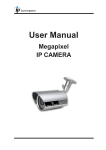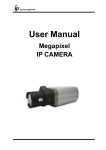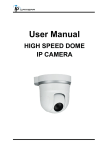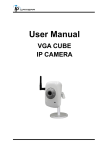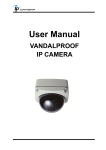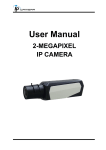Download User Manual - Security Cameras
Transcript
User Manual INDOOR DOME IP CAMERA WARINGS TO REDUCE THE RISK OF FIRE OR ELECTRIC SHOCK, DO NOT EXPOSE THIS PRODUCT TO RAIN OR MOISTURE. DO NOT INSERT ANY METALLIC OBJECT THROUGH VENTILATION GRILLS. CAUTION CAUTION RISK OF ELECTRIC SHOCK DO NOT OPEN CAUTION: TO REDUCE THE RISK OF ELECTRIC SHOCK. DO NOT REMOVE COVER (OR BACK). NO USER-SERVICEABLE PARTS INSIDE. REFER SERVICING TO QUALIFIED SERVICE PERSONNEL. COPYRIGHT THE TRADEMARKS MENTIONED IN THE MANUAL ARE LEGALLY REGISTERED TO THEIR RESPECTIVE COMPANIES. 2 CONTENT III Preface 4 IIII Product Specifications 4 IIIII Product Installation 9 AAA Monitor Setting 9 BBB Hardware Installation 10 CCC IP Assignment 12 DDD Install ActiveX control 14 IIII Live Video 20 VVV IP Camera Configuration 22 AAA System 23 BBB Network 27 CCC A/V Setting 47 DDD Event List 54 VVVV Network Configuration 64 VVVVV I/O Configuration 66 VVVVVV Factory Default 69 IIII Universal Password 70 XXX 73 Package Contents XXXX Micro SD Card Compatibility 74 V1.0_130605 III Preface This IP Camera is a 1.3 megapixel dome IP camera with the web server built in. User can view real-time video via IE browser. IP Camera supports simultaneously H.264, Motion JPEG & MPEG4 video compression and dual streaming which provides smooth and high video quality. The video can be stored in the SD card and played back remotely. With user friendly interface, it is an easy-touse IP camera which is designed for security application. IIII Product Specifications Main Features: •• 1.3 Mega Indoor IP Camera •• Support HD 720P Real Time •• Digital Noise Reduction •• Digital Wide Dynamic Range •• Shutter Speed Adjustable •• Sense Up Adjustable •• Day&Night Switch Time Control Manfully (Option) •• Power over Ethernet (Option) •• H.264/ M-JPEG/ MPEG4 Compression •• Micro SD Card Backup •• Support iPhone/Android/Mac •• SDK for Software Integration •• Free Bundle 36 ch Recording Software Fixed Lens Model PoE Model IR Model PoE + IR Hardware CPU RAM Flash Image sensor Sensitivity Shutter Time ARM 9 ,32 bit RISC 128MB 16MB 1 / 4” Mega-Pixel CMOS sensor B / W: 0.5 Lux (AGC Color : 1 Lux (AGC ON) ON) B / W: 0.5 Lux (AGC ON) 1 / 10~ 1 / 10,000 sec Lens Type 4.2mm @ F1.6 Angle of View 52.6° (H), 32.9° (V) 4 I/O 1 DI / 1 DO Audio G.711(64K) and G.726(32K,24K) audio compression Input : External Mic in Output: External Audio out Yes No Yes 12V DC:2.4W 12V 12V DC: PoE:2.88W DC:4.32W(IR 3.24W(IR On); On); 2.76W(IR 2.76W(IR Off) Off) PoE: 4.32W(IR On); 3.36W(IR Off) 0°C ~ 45°C Power over Ethernet Max Power Consumption Operating Temperature Dimensions IR LEDs (Option) 131.2mm (∅) x 94.3mm (H) LEDs IR distance Network No No 28 LEDs, 850nM, 7 LEDs, 850nM, 16M 5M Ethernet Network Protocol 10/ 100 Base-T HTTP, HTTPS, SNMP, QoS/DSCP, Access list, IEEE 802.1X, RTSP, TCP/ IP, UDP, SMTP, FTP, PPPoE, DHCP, DDNS, NTP, UPnP, 3GPP, SAMBA, Bonjour System Video Resolution Video Adjust Triple Streaming Image Snapshot Full Screen Monitoring Privacy Mask 1280x1024@20fps, 1280x720@30fps, ,640x480@30fps, 320x240@30fps, 176x144@30fps Brightness, Contrast, Hue, Saturation, Sharpness, AGC, Shutter Speed adjustable, SenseUp, D-WDR, Flip, Mirror, Noise reduction Yes Yes Yes Yes, 3 different areas 5 Brightness, Contrast, Hue, Saturation, Sharpness, AGC, Shutter Speed adjustable, Sense-Up, D-WDR, Flip, Mirror, Noise reduction, Day&Night adjustable Compression Format Video Bitrates Adjust Motion Detection Triggered Action Pre/ Post Alarm Security H.264/ M-JPEG/ MPEG4 CBR, VBR Yes, 3 different areas Mail, FTP, Save to Micro SD card, SAMBA, DO Yes, configurable Password protection, IP address filtering, HTTPS encrypted data transmission, 802.1X port-based authentication for network protection, QoS/DSCP Firmware Upgrade HTTP mode, can be upgraded remotely Simultaneous Up to 10 Connection Micro SD card management Recording Trigger Motion Detection, IP check, Network break down (wire only),Schedule, DI Video Format AVI, JPEG Video Playback Yes Delete Files Yes Web browsing requirement OS Windows 7, 2000, XP, 2003, Microsoft IE 6.0 or above, Chrome, Safari, Firefox. Mobile Support iOS 4.3 or above, Android 1.6 or above. Hardware Suggested Intel Dual Core 2.53G,RAM: 1024MB, Graphic card: 128MB Minimum Intel-C 2.8G, RAM: 512MB, Graphic card: 64MB Vari-focal Model PoE Model IR Model Hardware CPU RAM Flash Image sensor Sensitivity Shutter Time ARM 9 ,32 bit RISC 128MB 16MB 1 / 4” Mega-Pixel CMOS sensor B / W: 0.5 Lux (AGC ON) Color : 1 Lux (AGC ON) B / W: 0.5 Lux (AGC ON) 1 / 10 ~ 1 / 10,000 sec Lens Type 2.8~10mm @ F1.2 Angle of View 25.7°~88.1°(H), 16.1°~54.9°(V) I/O 1 DI / 1 DO 6 Audio Power over Ethernet Max Power Consumption G.711(64Kbps)/ G.726(24Kbps/32Kbps) audio compression Input : External Mic in Output: External Audio out Yes 12V DC: 2.4W PoE: 2.88W No 12V DC : 4.08W (IR On); 2.52W(IR Off) Operating Temperature 0°C ~ 45°C Dimensions IR LEDs (Option) 131.2mm (∅) x 94.3mm (H) LEDs IR distance Network No No Ethernet Network Protocol 10/ 100 Base-T HTTP, HTTPS, SNMP, QoS/DSCP, Access list, IEEE 802.1X, RTSP, TCP/ IP, UDP, SMTP, FTP, PPPoE, DHCP, DDNS, NTP, UPnP, 3GPP, SAMBA, Bonjour 18 LEDs, 850nM, 12M System Video Resolution Video Adjust 1280x1024@20fps, 1280x720@30fps, ,640x480@30fps, 320x240@30fps, 176x144@30fps Brightness, Contrast, Hue, Saturation, Sharpness, AGC, Shutter Speed adjustable, Sense-Up, D-WDR, Flip, Mirror, Noise reduction Brightness, Contrast, Hue, Saturation, Sharpness, AGC, Shutter Speed adjustable, SenseUp, D-WDR, Flip, Mirror, Noise reduction, Day&Night adjustable Triple Streaming Image Snapshot Full Screen Monitoring Privacy Mask Yes Yes Yes Yes, 3 different areas Compression Format Video Bitrates Adjust Motion Detection Triggered Action Pre/ Post Alarm H.264/ M-JPEG/ MPEG4 CBR, VBR Yes, 3 different areas Mail, FTP, Save to Micro SD card, SAMBA, DO Yes, configurable 7 Security Password protection, IP address filtering, HTTPS encrypted data transmission, 802.1X port-based authentication for network protection, QoS/DSCP Firmware Upgrade HTTP mode, can be upgraded remotely Simultaneous Connection Up to 10 Micro SD card management Recording Trigger Motion Detection, IP check, Network break down (wire only),Schedule, DI AVI, JPEG Yes Yes Video Format Video Playback Delete Files Web browsing requirement OS Windows 7, 2000, XP, 2003, Microsoft IE 6.0 or above, Chrome, Safari, Firefox. Mobile Support iOS 4.3 or above, Android 1.6 or above. Hardware Suggested Minimum Intel Dual Core 2.53G,RAM: 1024MB, Graphic card: 128MB Intel-C 2.8G, RAM: 512MB, Graphic card: 64MB *SPECIFICATIONS ARE SUBJECT TO CHANGE WITHOUT NOTICE. 8 IIIII Product Installation AAAMonitor Setting 111Right-Click on the desktop. Select “ Properties” 222Change color quality to highest (32bit). 9 BBBHardware Installation 111Camera Construction Use the screws to lock the bracket to the wall or ceiling, adjust the angle of lens, and then close the cover. 222Connector Instruction Connect power adaptor first, then connect the IP Camera to PC or network, and set up the network configurations according to the network environment. About I/O setting, please refer to chapter VII in User Manual: "I/ O Configuration" for detail. 10 333PoE ( Power Over Ethernet)(Optional) 802.3af PoE Switch is recommended Power over Ethernet (PoE) is a technology that integrates power into a standard LAN infrastructure. It enables power to be provided to the network device, such as an IP phone or a network camera, using the same cable as that used for network connection. It eliminates the need for power outlets at the camera locations and enables easier application of uninterruptible power supplies (UPS) to ensure 24 hours a day, 7 days a week operation. 11 CCCIP Assignment 111You can use the software“IP Installer” to assign the IP address of IP Camera. The software is in the attached CD. 222There are two language versions of IP installer. Choose one as your need: IPInstallerCht.exe: Chinese version IPInstallerEng.exe: English version 333There are 3 kinds of IP configuration. aaaFixed IP (Public IP or Virtual IP) bbbDHCP (Dynamic IP) cccDial-up (PPPoE) 444Execute IP Installer 555For Windows XP SP2 user, the following message box may pop up. Please click “Unblock”. 666IP Installer configuration: 12 777IP Installer will search for all IP Cameras connected on Lan. Click “Search Device” to refresh the result list. 888Click one of the IP Camera listed on the left side. The network configuration of this IP camera shows on the right side. You may change the “name” of the IP Camera as your preference (eg: Office, warehouse). Change the parameter and click “Submit” . It will apply the change and reboot the Device. 999Please make sure that the IP address of your PC and IP Camera are on the same subnet. The same Subnet: IP CAM IP address: 192.168.1.200 PC IP address: 192.168.1.100 Different Subnets: IP CAM IP address: 192.168.2.200 PC IP address: 192.168.1.100 To Change PC IP address: Control Panel→Network Connections→ Local Area Connection Properties→ Internet Protocol (TCP/IP) → Properties 1111A quick way to access remote monitoring is to double-click the selected IP 13 Camera listed on “Device list” of IP Installer. An IE browser will be opened. 1111If you link to the IP Camera successgully, there pops a box asking you to log in. Please key in the default user name"admin" and password"admin" when you link to the IP Camera for the first time. You can revise the user name and password later. Please refer to Chapter V: "A.2. User Management". DDDInstall ActiveX control 111To users of IE 6.0 above At the first time you access the camera via IE, it will ask you to install the ActiveX component. If the installation failed, please check the security setting for the IE browser. aaaFollow the steps: IE→Tools → Internet Options… → Security Tab → Custom Level… → Security Settings. Find the option "Download unsigned ActiveX control"→ Select “Enable” or Prompt. Find the option "Initialize and script ActiveX controls not marked as safe" → Select “Enable” or Prompt. 14 1 2 3 4 5 When popup the following dialogue box, click “Yes”. 15 bbbYou can choose another way. Go to: IE→Tools → Internet Options… → Security Tab → Trusted sites → Add the IP address and click "OK". In the site list you can key one single IP address or a LAN address. For example, if you add "192.168.21.*", all the IP address under .21 LAN will be regarded as trusted sites. 16 222Use Non-IE Web Browser If you use firefox or google chrome to access the IP camera but fail to watch the live video, please follow the steps to install necessary tools: (the following pictures are based on chrome.) aaaYou may see the prompt message as the picture below. First, Click the link: "Firstly, please install Microsoft Visual C++ 2010 Redistributable Package (x86)." (((( The link conducts you to the Microsoft official site that you can download the tools. Please select the language and click "download". ((((( In the pop-up window, please tick the first and the third file as the picture below. Click "Next" to download both "Microsoft .NET Framework 4 Client Profile (Web Installer)" and "Microsoft Visual C++ 2010 Redistributable Package (x64)". 17 (((((( After fininshing downloading, execute the two files respectively to install them.The windows may ask you to reboot the PC when the installation finished. bbbThen, Click the second link "Please click here to download the installation program which does not support IE browser." to download Setup ActiveX. After fininshing downloading, execute the files to install ActiveX. Then restart the browser. 18 cccIf you execute the steps above but still cannot see the live video normally, please try the solution: (((( Search for the file "np_hoem_x.dll" in your system disk. For Windows XP users, please go to "Start" → "Search" → Search for "All files and folders" and key in "np_hoem_x.dll". For Windows 7 users, please use the search bar on the top-right of the Windows Explorer. ((((( Delet all the files named "np_hoem_x.dll". They're the ActiveX control tools having been installed in your computer, but the old version of ActiveX might not compatible with the new version of browser. Therefore, we delete them in order to install the latest ActiveX control. (((((( Start your web browser, and repeat the step 2-b: "Download the installation program which does not support IE browser" to download and install ActiveX. 19 IIII Live Video Start an IE browser, type the IP address of the IP camera in the address field. It will show the following dialogue box. Key-in the user name and password. The default user name and password are “admin” and “admin”. When the IP Camera is connected successfully, it shows the following program interface. Double-click the video to switch to full screen view. Press “Esc” or doubleclick the video again back to normal mode. 111 : Get into the administration page 222 : Video Snapshot 20 333Show system time, video resolution, and video refreshing rate 444Adjust image, 1/2x, 1x, 2x 555Select video streaming source (If in”Video Setting” the streaming 2 setting is closed, this option will not appear here.) 666IP Camera supports 2-way audio. Click the “Chatting” check box, then you can use microphone connected to the PC to talk to the Camera side. 777Show how many people connect to this IP camera. 888Tick the Relay out "ON" box to trigger the relay output for testing. Tick "Off" to stop triggering. Right-Click the mouse on the video, it will show a pop-up menu. 111Snapshot: Save a JPEG picture 222Record Start: Record the video in the local PC. It will ask you where to save the video. To stop recording, right-click the mouse again. Select “Record Stop”. The video format is AVI. Use Microsoft Media Player to play the recorded file. 333Mute: Turn off the audio. Click again to turn on it. The "mute" botton does not affect the playback recording video. As long as the "IP Camera to PC" option in the audio setting is enabled, all the audio will be recorded into the playback video even you click "mute" in the live page. 444Full Screen: Full-screen mode. 555Zoom: Enable zoom-in and zoom-out functions. Select “Enable digital zoom” option first within the pop-up dialogue box and then drag and drop the bar to adjust the zoom factors. 666Frame Buffm Sec: This function is to build a temporary buffm to accumulate several video frame. This function can make video smooth-going when the Network speed is slow and lag. If you select “100”, then it plays video after 100 mSec when starting receiving images from camera. The slower the Network is, the bigger value should be selected. The default value is null. 21 VVV IP Camera Configuration Click to get into the administration page as below. Click to back to the live video page. 22 AAASystem 111System Information aaaServer Information: Set up the camera name, select language, and set up the camera time. (((( Server Name: This is the Camera name. This name will show on the IP Installer. ((((( Select language: There are 11 languages to choose from. When you change the language, it will show the following dialogue box for confirmation. bbbOSD Setting: Select a position where date & time stamp / text showing on screen. Click Text Edit to adjust the OSD text contents. Alpha means background transparency of the text. If you select 100%, the text stamp will be directly displayed on the live screen. If you select 0%, the text stamp will be displayed with a black background. 23 cccServer time setting: Select options to set up time - “NTP”, “Synchronize with PC’s time”, “Manual”, “The date and time remain the same”. •• Server Time: It shows current IPCam server time. •• Date Format: Select the date display format. •• Time Zone: Select your time zone. It affects server time when you use “NTP” time. •• Enable Daylight Saving: Give the start and end daylight saving time. During daylight saving, the time will be 1 hour faster. •• NTP: Key in the NTP server IP address and update interval. The camera time will be synchronized with NTP server time. To use this option, if the NTP Server is under WAN, the camera must be set to access WAN. •• Synchronize with PC’s time: In “Date” and “Time” column it shows your current PC time. Click “Apply” to make the camera time the same with PC time. •• Manual: Key in the date and time, and click “Apply”. •• The date and time remain the same: After you select “Synchronize with PC’s time” or “Manual”, and click “Apply”, the selected mark will jump to this option. 24 222User Management IP CAMERA supports three different users, administrator, general user, and anonymous user. aaaAnonymous User Login: Select “Yes”, then anyone access the camera can watch the live video without username and password. However, If you try to enter the configuration page, the camera will ask you to key in the username and passwork to log in. Selec "No", then username and password are required to access the camera. bbbUniversal Password: Select “Yes”, then user is allowed to login this IPCam by universal password. Please refer to “Universal Password” chapter for the function explanation. Select “No”, then the universal password function is disabled. cccAdd user: Type the user name and password, then click “Add/Set”.The guest user can only browse the live video page and is not allowed to enter the configuration page. dddClick “Edit” or “Remove” in the user list to modify them. The system will ask you to key in the password in the pop-up window before you edit the user information. 25 333System update: aaaTo update the firmware online, click “Browse…” to select the firmware. Then click “Upgrade” to proceed. Note: The firmware upgrade might be accompanied by the changing of some setting and function, and the setting options might become different to the user manual that you're reading now. bbbReboot system:re-start the IP camera cccFactory default:delete all the settings in this IP camera. dddSetting Management:User may download the current setting to PC, or upgrade from previous saved setting. (((( Setting download: Right-click the mouse button on Setting Download → Select “Save AS…” to save current IP CAM setting in PC → Select saving directory → Save ((((( Upgrade from previous setting: Browse → search previous setting → open → upgrade → Setting update confirm → click index.html. to return to main page 26 BBBNetwork 111IP Setting aaaIP Assignment IP Camera supports DHCP and static IP. (((( DHCP: Using DHCP, IP CAMERA will get all the network parameters automatically. ((((( Static IP: Please type in IP address, subnet mask, gateway, and DNS manually. bbbIPv6 Assignment IPv6 is a newer numbering system that provides a much larger address pool than IPv4, which accounts for most of today’s Internet traffic. You can manually key in IPv6 address, enable DHCPv6, and use automatically generated IPv6 address simultaneously. (((( Manually setup the IPv6 address: Key in Address, Gateway, and DNS. ((((( DHCPv6: If you have a DHCPv6 server, enable it to assign the IPv6 automatically. The assigned IP address will be displayed beside the column. (((((( Automatically generated IPv6 Address: Here indicates a virtual IPv6 27 address generated automatically by IP camera. This virtual IPv6 address cannot use on WAN. To use IPv6 address to access the IP camera, please open the web browser, and key in [IPv6 address] in address bar. The [ ] parentheses mark is necessary. cccPort assignment (((( Web Page Port: setup web page connecting port and video transmitting port (Default: 80) ((((( HTTP Port:setup HTTPS connecting port (Default:443) dddUPnP (Universal Plug and play) This IP camera supports UPnP, If this service is enabled on your computer, the camera will automatically be detected and a new icon will be added to “My Network Places.” (((( UPnP Port Forwarding: When the camera is installed under a router, Enable UPnP Port Forwarding to let the router open ports so that the video streams can be sent out from a LAN. Set Web Port, Http Port, and RTSP port, and make sure your router supports UPnPTM and the function has been activated. ((((( Note: UPnP must be enabled on your computer. Please follow the procedure to activate UPnP. <Approach 1> •• Open the Control Panel from the Start Menu •• Select Add/Remove Programs •• Select Add/Remove Windows Components and open Networking Services section •• Click Details and select UPnP to setup the service 28 •• The IP device icon will be added to “MY Network Places” •• User may double click the IP device icon to access IE browser <Approach 2> •• Open "My Network Space", and click "Show icons for networked UPnP devises" in the tasks column on the left of the page. Windows may ask your confirmation for enabling the components. Click "Yes". •• Now you can see the IP devise under the LAN. Double-click the icon to access the camera via web browser. To disable the UPnP, click "Hide icons for networked UPnP devises" in the tasks column. 29 eeeRTSP setting If you have a media player that supports RTSP protocal, you can use it to receive the video streaming from IP camera. The RTSP address can be set for two streamings respectively. Please jump to Chapter V-C:"Video Setting". There're setting field for RTSP address of two streamings. (((( RTSP Server: enable or disable ((((( RTSP Authentication: "Disable" means everyone who knows your camera IP Address can link to your camera via RTSP. No username and password are required. Under "Basic" and "Digest" authentication mode, the camera asks the user to give username and password before allows accessing. The password are transmitted as clear text under basic mode, which provides a lower level of security than under digest mode. Make sure your media player supports the authenticaton schemes. (((((( RTSP Port: setup port for RTSP transmitting (Default: 554) (((((RTSP Start and End Port: in RTSP mode, you may use TCP and UDP for connecting. TCP connection uses RTSP Port (554). UDP connection uses RTSP Start and End Port. fffMulticast Setting (Based on the RTSP Server) Multicast is a bandwidth conservation technology. This function allow several user to share the same packet sent from IP camera. To use 30 Multicast, appoint IP Address and port here. TTL means the life time of packet, The larger the value is, the more user can receive the packet. To use Multicast, be sure to enable the function "Force Multicast RTP via RTSP" in your media player. Then key in the RTSP path of your camera: "rtsp://(IP address)/" to receive the multicast. gggONVIF (((( Choose your ONVIF version and settings. Under ONVIF connection, the video will be transmitted by RTSP. Be sure to enable the RTSP server in IP setting, or you're not able to receive the video via ONVIF. ((((( Security: Select "Disable", then the username and password are not required when accessing the camera via ONVIF. Select "Enable", then username and password are necessary. (((((( RTSP Keepalive: When the function is enabled, the camera checks once in a while if the user who links to the camera via ONVIF still keeps connecting. If the connection had been broken, the camera stop transmitting video to user. hhhBonjour This function enable MAC systems to link to this IP camera. Key in the name here. The web browser "Safari" also has Bonjour function. Tick "Include Bonjour" in the bookmark setting, and you can see the IP camera appearing under the bonjour category. Click the icon to connect the IP camera. So far the Bonjour function on Safari browser doesn't support HTTPS protocol. If you select "https" mode for the camera, you can see the camera appearing on Safari's bookmarks but cannot access camera via it. 31 iiiLLTD If your PC supports LLTD, enable this function then you can check the connection status, properties, and device position(like IP address) of this IP Camera in the network map. In the computer running Windows Vista or Windows 7, you can find LLTD through the path: Call out the Control Panel → Network and Internet → Network and Sharing Center → Click "See full map". 32 222Advanced aaaHttps (Hypertext Transfer Protocol Secure) When the users access cameras via Https protocol, the transmitted information will be encrypted so that the security level is arisen. You can select the connection type. •• Http: user can access the camera via Http path but cannot via Https path. •• Https: user can access the camera via Https path but cannot via Http path. •• Http & Https: Both the Http and Https path can be used to access the camera. When you change the setting of connection type, it may cause connection error or disconnection error if you switch the protocol directly. Therefore, Http & Https mode is necessary. If you want to change from Http to Https, please switch to “Http & Https” mode first, and then switch to “Https” mode. Vise versa. Https protocol has certificate verifying mechanism. When the user access a website via Https, the browser will check the certificate of that domain and verify its trustiness and secure. Certificate generation process: (((( Remove the existing certificate: Before you generate a new certificate, please remove installed one. Select "Http" connection type and click "Remove". If a dialog box pops up to ask you to confirm, click “Yes”. 33 ((((( Created Request: Fill in the following form and click “apply”. (((((( After you generate a certificate request, if you choose to turn it to the trusted third-party to verify, please click “Content” and copy all the request content. (((((According to the certificate source, there are two ways to install the 34 certificate. If you had sent the certificate request to do sign and received a signed certificate, please click” browse” and find the certificate file in your computer. Click “Apply” to install it. If you choose to generate a self-signed certificate, fill in the following forms and set validity day, click “Apply” to finish installed it. After finishing installation, you can click “Content” to call out and check the certificate content. (((( To use Https to access camera, open your browser, and key in "https:// (IP address)/" in the address bar. Now your data will be transmitted via encrypted communications, and the browser will check your certificate status. If it shows you a warning message: That means your certificate is self-signed or signed by distrusted institution. Click “Proceed anyway” and you can continue going to the camera page. 35 bbbSNMP(Simple Network Management Protocol) SNMP provides a simple framework for administering networked hardware. To manage the IP camera, you have to prepare a MIB browser or similar tools first. SNMPv1, SNMPv2c, and SNMPv3 can be enabled simultaneously. The following examples are based on MG-SOFT MIB Browser. Depending on your MIS Browser, you may see different interface and options. Please refer to the user manual of your MIB Browser. (((( SNMPv1 and SNMPv2: The term "Community name" in SNMPv1 and SNMPv2c can be roughly regarded as key. The person who has the community name has the authority to read or edit the information of IP camera via SNMP. Tick the box to enable SNMPv1 or SNMPv2c protocal, and specify the community name for write(read and write) and read(read-only). The user who use read community name to access the IP camera cannot modify any data of this camera. The community name can be any English characters and numbers, and must be shorter than 31 bits. •• Example: Open the MIB Browser. Key in camera IP address(192.168.1.202), select SNMPv1 or SNMPv2, and key in the community name(Key in the 36 correct Read Community name “public”, the user has read authority to camera; Key in the correct Read Community name “public” and Key in the correct Set community name “write”, the user has write authority to camera.). Connection succeeds. ((((( SNMPv3: For data security reason, the authentication and encryption assurances are added when developing SNMPv3. The user has to give not only the security name(similar with "community name" in v1&v2c) but the password in order to access the IP camera. Please set security name, authentication type, authentication password, encryption type, encryption password of write and read respectively. The security name can be any English characters and numbers, and must be shorter than 31 bits. The password must be 8~64 bits in length. Different from in SNMPv1 and v2c, the user have to create a account when using SNMPv3. In the account parameters, key in the security name and password you set in the camera to get accessing. 37 •• Example: Select SNMPv3, add new user, and key in correct security user name(write). Select the same authentication type with camera setting for authentication protocol(MD5), and key in authentication password of write security. Select the same encryption type with camera setting for privacy protocol (DES), and key in encryption password of write security. Click OK to add the user who has write authority to the camera. Connection succeeds. If you want to add the new user who has read authority, key in correct security user name(public), key in authentication password of read security, and key in encryption password of read security. (((((( SNMPv1/SNMPv2 Trap: Trap is a mechanism that allows the a managed device to send messages to manager instead of waiting passively for polling from the manager. Specify the trap event. When those events happen, the camera will send the ring message to the Trap Address, which is usually the manager's IP address. Trap Community means the community that can receive the trap message. Note: Trap Address must be under the same LAN with IP camera. 38 •• Cold Start: The camera starts up or reboots. •• Setting changed: The SNMP setting is changed. •• Network Disconnected: The network connection was broken down. (The camera will send trap messages after the network being connected again) •• V3 Authentication Failed: A SNMPv3 user account tries to get authentication but failed. (Due to incorrect password or community) •• SD Insert / Remove: A Micro SD card is inserted or removed. •• Example: Open the MIB Browser. Use SNMPv1 or SNMPv2 to access the camera. When the SNMP setting is edited, Manager’s MIB Browser(192.168.40.159) will receive the trap message of “setting change“ from IP Camera (192.168.40.21). 39 cccAccess List You can deny an IP address or a range of IP address so that they cannot access the IP camera. Tick the "enable" box, key in the IP address you want to deny, select"deny" then click"Add" to add it to the list. You can also choose to deny a range of IP address but allow one or several IP address of them. Take the picture above for example, IP address 192.168.50.151~161 are not allowed to connect to the camera, but only 192.168.50.159 can access. Note: In the list "allow" condition must be ranked before "deny" condition. For example, if we exchange the sequence, set "Deny: 192.168.50.151~192.168.50.161" for the first item and "Allow: 192.168.50.159" for the second item in the list, the IP "192.168.50.159" turns out to be denied by the camera because the "deny" condition has the priority according to our ranking way. As for those IP addresses not included in the list, the default is “allow”. 40 dddQoS/DSCP(Quality of Server/Differentiated Services Code-point) DSCP specifies a simple mechanism for classifying and managing network traffic and provide QoS on IP networks. DSCP is a 6-bit in the IP header for packet classification purpose. Set up instruction: The number 0~63 for Live Stream, Event / Alarm, and Management represent the ratio that the bandwidth is divided. For example, if you set 5, 10, and 20 for the three items, then the bandwidth of the three item is 5:10:20. The item getting more bandwidth has lower probability to be delayed. There is no difference between setting "0, 0, 0" or "63, 63, 63" because under these two setting the three items will get equal bandwidth (1/3). The three stream control the protocols respectively: •• Live Stream (Video and audio) : RTP / RTSP •• Event/Alarm : FTP / SMTP / SAMBA / SIP •• Management : HTTPS / HTTP / SNMP Note: The "Management" stream handles both the live view and the setting area of the web page on which the data is transferred via http/https protocol. If you prefer to distribute more bandwidth when using the web browser to watch the live video, please adjust the Management Stream instead of Live Stream. 41 eeeIEEE 802.1x IEEE 802.1x is an IEEE standard for port-based Network Access Control. It provides an authentication mechanism to device wishing to attach to a LAN or WLAN. To use this function, you need a device to build IEEE 802.1x LAN at first. The EAPOL protocol support service identification and optional point to point encryption over the local LAN segment. Please check what version of the authenticator and authentication server support. This camera supports EAP-TLS method. Please enter ID, password issued by the CA, then upload related certificates. 42 333PPPoE & DDNS aaaPPPoE: Select “Enabled” to use PPPoE. Key-in Username and password for the ADSL connection. Send mail after dialed: When connect to the internet, it will send a mail to a specific mail account. For the mail setting, please refer to Server settings. bbbDDNS: It supports DDNS (Dynamic DNS) service. (((( Enable this service ((((( Key-in the DynDNS server name, user name, and password. (((((( Set up the IP Schedule update refreshing rate. (((((Click “Apply” (((( If setting up IP schedule update too frequently, the IP may be blocked. In general, schedule update every day (1440 minutes) is recommended 43 (((((DDNS Status •• Updating: Information update •• Idle: Stop service •• DDNS registration successful, can now log by http://<username>. ddns.camddns.com: Register successfully. •• Update Failed, the name is already registered: The user name has already been used. Please change it. •• Update Failed, please check your internet connection: Network connection failed. •• Update Failed, please check the account information you provide: The server, user name, and password may be wrong. 44 444Server setting The settings of Email, FTP and SAMBA are used when the event happens, schedule snapshot executes, or the alarm input is triggered. Select the item to display the detailed configuration options. You can configure either one or all of them. aaaMail Setting: Set up the server address and account information of your e-mail. Click “Apply” to save the setting, then use “Test” botton to test the server connection. A message box will tell you “OK!” if it works, and a test e-mail will be sent to receiver’s mail address. bbbFTP: Set up the server address and account information of your FTP. Click “Apply” to save the setting, then use “Test” botton to test the server 45 connection. A message box will tell you “OK!” if it works, and a test file will be uploaded to FTP space. In PORT mode, the FTP server builds the connection to the user's data port actively. However, from the user-side firewall's standpoint, the action of connecting from FTP server is often considered to be dangerous and should be blocked. In PASV mode, the problem is solved: The FTP server waits for the data transmission connection built by the user. Make sure that the server supports the mode you select. cccSamba: Select this option to send the media files via a network neighborhood when an event is triggered. Click “Apply” to save the setting, then use “Test” botton to test the server connection. A message box will tell you “OK!” if it works, and a test document will be created in the location. If the test failed, check the sharing setting of your location folder. The folder properties must be “shared” and the permissions must be “Full Control” as the picture. 46 CCCA/V Setting 111Image Setting For the security and privacy purpose, there are three areas can be setup for privacy mask. Click Area button first and drag an area on the above image, and remember to save your setting. The masked area will not show on both the live view and recording. Please refer to the details below for Image setting: aaaBrightness, Contrast, Hue, Saturation, Sharpness can be adjusted here. bbbAGC: Automatic gain control. The sensitivity of camera can adjusts with the environmental light. Enable this function and the brighter image can be got 47 under dim light, but the level of noise may also increase. cccShutter Time: Choose as the location of your camera or fixed shutter time. The shorter the shutter time is, the less light the camera receives and the image becomes darker. dddSense-Up: This function increases the sensitivity of camera to get brighter image at night. The smaller the value you select, the slower the shutter speed becomes so that the image will get brighter, and moving subjects might be blurred. Sense-Up option is only enabled when users select "outdoor" or "indoor" in shutter time option. eeeD-WDR: Digital wide dynamic range. This funtion enables the camera to reduce the contrast in the view to avoid the dark zones resulting from over and under exposure. fffVideo Orientation: Flip or mirror the image as your requirement. gggDay & Night: The camera can detect the light level of environment. If you select "Light Sensor Mode", the image will be turned to black and white at night in order to keep clear. Appoint a lux stantard of switching D/N. The current lux here is for reference. Under "Times Mode" the switch time of Color / Black and white is according to the given time. Under "Sychronize with DI" mode, the image will be turned to black and white when the camera receives triggering from DI. You can also control it by choosing "Color" or "B/W". hhhWhite Balance: Enhance red / blue color in the image. iiiDNR: Digital noise reduction. This function is able to filter the noise and blur from the image and show a clearer view. Select the DNR extent. 48 Note: When you select a number in "Shutter Time", actually the shutter time varies in a range and controlled by camera automatically. Following table shows the shutter time option and corresponding range. Option Outdoor Indoor Shutter Time Range (sec.) 1/10000 ~ Selected number in "Sense-up" NTSC: 1/125 ~ Selected number in "Sense-up" PAL: 1/100 ~ Selected number in "Sense-up" 1/30 1/10000 ~ 1/30 1/50 1/10000 ~ 1/50 1/60 1/10000 ~ 1/60 1/100 1/10000 ~ 1/100 1/125 1/10000 ~ 1/125 1/250 1/10000 ~ 1/250 1/500 1/10000 ~ 1/500 1/1000 1/10000 ~ 1/1000 * Sense-up options: 1/30, 1/15, 1/10, 1/5 49 222Video Setting aaaVideo System Setting: Choose the input resolution, the option affects the max value of video frame rate. Choose the Video System, NTSC or PAL. bbbBasic Mode of Streaming 1 and Streaming 2: (((( Resolution: If “1280x1024 @20fps” is selected in Input Resolution option, you can select 1280x1024, 640x480, 320x240,or 176x144 here. If “1280x800 @30fps” is selected in Input Resolution, you can select 1280x800, 1280x720, 640x480, 320x240, or 176x144 here. ((((( Quality: The higher the quality is, the bigger the file size is. It might affect Internet transmitting speed if the file gets too large. (((((( Video Frame Rate: The video refreshing rate per second. The max value is affected by the input resolution you choose. (((((Video Format: H.264, MPEG4, or M-JPEG (((( RTSP Path: Set the RTSP output connecting route. 50 cccAdvanced Mode of Streaming 1 and Streaming 2: (((( Resolution: If “1280x1024 @20fps” is selected in Input Resolution option, you can select 1280x1024, 640x480, 320x240,or 176x144 here. If “1280x800 @30fps” is selected in Input Resolution, you can select 1280x800, 1280x720, 640x480, 320x240, or 176x144 here. ((((( Bitrate Control Mode: In CBR(Constant Bit Rate) mode, the bitrate keeps consistent all over the video. In VBR(Variable Bit Rate) mode, the bitrate changes with the complexity extent of the video data. VBR provides a better compression way and the file may be smaller. However, the VBR file size cannot be predicted. The image may become broken or lagged when your bandwidth is not enough for the data quantity you selected. (((((( Video Quantitative: The quality parameter of VBR. You can choose 1~10 compression rate. The higher the value is, the higher the image quality is. (((((Video Bitrate: The quality parameter of CBR. You can choose 32kbps ~10Mbps. The higher the value is, the higher the image quality is. (((( Video Frame Rate: The video refreshing rate per second. The max value is affected by the input resolution you choose. (((((GOP Size: It means “Group of Pictures”. The higher the GOP is, the better the quality is. ((((((Video Format: H.264, MPEG4, or M-JPEG (((((((RTSP Path: RTSP output connecting route. 51 ddd3GPP Streaming mode: To receive video via 3gpp, please remember to enable rtsp server in the "IP Setting" page. 3GPP mode fixed setting: 176x144 resolution, 5FPS, Video compression: MPEG4, Audio compression: AMR. (((( Enable or Disable 3GPP Streaming ((((( 3GPP Path: 3GPP output connecting route. If the IP address of your camera is 192.168.40.150, and you key in "3g" in the column, the 3GPP path will be rtsp://192.168.40.150/3g. 52 333Audio: IP Camera supports 2-way audio. Audio can be receive by the mic connected with the IP camera and transmitted to remote PC. User can also send audio from remote PC mic to IP Camera’s external speaker. aaaIP Camera to PC To receive Audio from IP camera, select “Enable” to start this function. The Audio compression format can be choosed from 3 options. You can also adjust the volume of 2-way audio. bbbPC to IP Camera Tick “chatting” box in the browsing page, then your voice can be propagated from PC to camera. If "Chatting" and "Save to SD card" are enabled simultaneously, the sound quaily might be affected and becomes not smooth. 53 DDDEvent List IP Camera provides multiple event settings. 111Event Setting aaaMotion Detection To enable motion detection, please tick "Area 1/2/3". Click "Area 1/2/3" in Area Setting, and draw an area on the preview screen. When motion in the area is detected, "Motion!" word will be marked on the live screen, and the camera can send video or snapshot to specific mail addresses, trigger the output devise, or save video to FTP/ Micro SD card/ Samba. If you select "save to SD card", the video or sanpshot will be saved to Micro SD card. If you also tick E-mail/ FTP/ Samba of "Log" option, the motion detection log will be sent to E-mail/ FTP/ Samba simultaneously. •• Intervel: For example, if you select "10 sec" here, once the motion is detected and action is triggered, it cannot be triggered again within 10 seconds. •• Based on the schedule: When the option box is ticked, only during the selected schedule time the motion detection is enabled. That is, for example, the 11th hour of 54 Monday has not been colored in the schedule table, then no action will be triggered even the camera detects motion during 11:00~12:00 on Monday. bbbTampering Detection When the camera view is covered, moved, shot by strong light, or out of focus, the tampering detection will be triggered, and send snapshot or video to mail/FTP/Samba/SD card, or trigger the external alarm. Please select the alarm action. •• Interval: The tampering detecting interval. Take the diagram for example, we set interval as 30 second, and the camera lens is covered during 1040 sec. At timepoint B, the camera compare the view with timepoint A, and send alarm when it found that the lens is covered. At timepoint C, the camera compare the view with timepoint B, and send alarm when it found that the lens is uncovered. cccRecord File When a event happens, the IP camera can record a video clip or take snapshot, and then send to mail/ FTP/ Samba. Select what format you want to save. •• AVI File (with Record Time Setting): Save AVI video file. The video length is according to the value you set in Record Time Setting. •• JPEG File (Single File with Interval Setting): Save single JPEG picture file when event happens. •• JPEG Files (with Record Time Setting): Only when you select "JPEG" in 55 streaming 1 video format of Video Setting, this option can be enabled. Select this option to save several JPEG picture files, and the successive picture files cover a period of time according to the value you set in Record Time Setting. dddRecord Time Setting When a event happens, the IP camera can record a video clip or take snapshot, and then send to mail/ FTP/ Samba. Select the video recording length before and after event happens. •• Diagram example of "Interval" and "Pre/ Post Alarm": eeeNetwork Dis-connected To avoid video loss, the camera will start to save the video to local Micro SD card when it detect Ethernet cable is unplugged. The video recording will continuously be saved into Micro SD card and divided into every 5 minutes a file until the network is reconnected successfully. The oldest file will be deleted if the capacity of Micro SD card is full. This function is only enabled under wire connection. 56 fffNetwork IP check The same with "Network Dis-connected" function, Network IP chech is designed for avoiding video loss. Even when the Ethernet cable is plugged, the network might be sometimes not stable. Key in the target IP address and interval. The camera checks once in a while according to the setting interval time that if itself can access the target IP address. If PIN failed, the camera can start saving the video to Micro SD card. If PIN failed four time successively, the camera can reboot itself. 57 222Schedule aaaSchedule: After complete the schedule setup, the camera data will be recorded according to the schedule setup. bbbSnapshot: After enable the snapshot function, user can select the storage position of snapshot file, the interval time of snapshot and the reserved file name of snapshot. cccInterval: The interval between two snapshots. 58 333I/O Setting aaaInput Setting: IP Camera supports input and output. When the input condition is triggered, it can trigger the relay out, send the video to mail addresses /FTP server / SAMBA. •• Intervel: For example, if you select "10 sec" here, once the input alarm is detected and action is triggered, it cannot be triggered again within 10 seconds. •• Based on the schedule: When the option box is ticked, only during the selected schedule time the I/O is enabled. That is, for example, the 11th hour of Monday has not been colored in the schedule table, then no action will be triggered even the camera detects input signal during 11:00~12:00 on Monday. bbbOutput Setting: The output mode affect the DO or relay out duration. (((( OnOff Switch: The camera triggers the external devise and lasts for certain of time according to the event "interval" setting. If it's triggered by motion detection, the triggering time is according to "interval" setting of motion detection. If it's triggered by external input alarm, the triggering time is according to input "interval" setting. It triggers the external devise and lasts for 10 seconds if you select "10" in interval setting. You can turn off the alarm manually by click "off" at the right bottom of the live video page. ((((( Time Switch: The camera triggers the external devise and lasts for certain of time according to the output "interval" setting, and the user is not allowed to break off the alarm manually. 59 444Log List Sort by System Logs, Motion Detection Logs and I/O Logs. In addition, System Logs and I/O Logs won’t lose data due to power failure. 60 555SD card aaaPlayback Please Insert Micro SD card before use it. Make sure pushing Micro SD card into the slot completely. Click the date listed on this page, and it shows the list of the video. The video format is AVI. Click the video to start Microsoft Media Player to play it. To delete the video, check it, then click "Del". bbbSD Management "Auto Deletion” means the recoding files will be deleted after several days as you selected. Example: If “The 2st day” is selected, then the recording file at 2012/11/21 5:00AM will be deleted from SD card at 2012/11/23 5:00AM. That is, if the user check the SD card at 2012/11/21 5:00AM, he can only find the recording files between 2012/11/19 5:00AM ~ 2012/11/21 5:00AM. The oldest file will be deleted if the SD card is full. Note:The use of the SD card will affect the operation of the IP Camera slightly, such as affecting the frame rate of the video. 61 cccCopy to PC You can insert the Micro SD card to PC and read the files directly, or use FlashGet instead to download the files from IP camera. (In this way you do not need to pull out Micro SD card from the camera.) To use FlashGet for downloading the image and video data from the Micro SD card, please follow the steps: (((( Enter the data list and right-click "Files link daily", select "save target as..." to save the link list to PC. ((((( Open FlashGet, select "File" → "Import" → "Import list", and find the link list file you just saved. The file name may be called "SD_list". (((((( FlashGet will show you the link list, and you can tick the files you want to copy to your PC. Give the directory path in the new download window, and remember to enable "Login to Server": key in the IP Camera username and password. 62 (((((Click OK to start download. •• FlashGet is a free software that can be downloaded from FlashGet official website. The example above is based on FlashGet ver.1.9.6. 63 VVVV Network Configuration •• Configuration 1: aaaInternet Access: ADSL or Cable Modem bbbIP address: One real IP or one dynamic IP cccOnly IP Camera connects to the internet dddFor fixed real IP, set up the IP into IP Camera. For dynamic IP, start PPPoE. •• Configuration 2: aaaInternet AccessL: ADSL or Cable Modem bbbIP address: More than one real IP or one dynamic IP cccIP Camera and PC connect to the internet dddDevice needed: Switch Hub eeeFor fixed real IP, set up the IP into IP Camera and PC. For dynamic IP, start PPPoE. 64 •• Configuration 3: aaa Internet Access: ADSL or Cable Modem bbbIP address: one real IP or one dynamic IP cccIP Camera and PC connect to the internet dddDevice needed: IP sharing eeeUse virtual IP, set up port forwarding in IP sharing. 65 VVVVVI/O Configuration 111 I/O Connection aaaPlease connect the GND & DO pin to the external relay (buzzer) device. bbbPlease connect the GND & DI pin to the external trigger device. When no event happens, DO output is 5V (DO and GND are disconnected). When the camera detects event happening and triggers external alarm, DO output is 0V (DO and GND are connected). If you select "N.O" in "Input sensor setting", when external devise or circuit makes DI and GND pin connected, the camera input alarm is triggered, and then camera will execute the action user has set, for example, send snapshot to E-mail address. If you select "N.C" in "Input sensor setting", when external devise or circuit makes DI and GND pin disconnected, the camera input alarm is triggered, 66 and then camera will execute the action user has set, for example, send snapshot to E-mail address. cccI/O PIN definition •• GND (Ground): Initial state is LOW •• DO (Digital Output): DC 5V •• DI (Digital Input): Max. 50mA, DC 5V 222I/O Setup aaaClick I/O Setting from the system setup page via IE, and check “Out1” to enable I/O signal. bbbOutput Test After the external input and output hardware is installed, you can use the "Relay Out" bottom on the live video page to test if DO / Relay Out works. (((( OnOff Switch mode: Click "ON", the camera will trigger the external output devise. For example, your alarm buzzer will continuously ring. You can manually break off the output signal by clicking "OFF". 67 ((((( Time Switch mode: Click "Pulse", the camera will trigger the external output devise for several seconds, The duration length is according to the "interval" setting in Output Setting. 68 VVVVVVFactory Default If you forget your password, please follow the steps to revert back to default value. •• Remove the power adapter and the ethernet cable. Press and hold the button in the IP CAMERA. •• Connect the power to the camera. Don’t release the button during the system booting. •• It takes around 30 seconds to boot the camera. •• Release the button after the camera finishes booting. •• Plug in the ethernet cable. Re-login the camera using the default IP (http://192.168.1.200), and user name (admin), password (admin). 69 IIII Universal Password If you forgot the password of your IP camera, you can reset the camera to factory default, or follow the procedure below to generate a universal password. Note: Universal password will be valid only when you enable the function in User Management. 111First, you need to know the IP address and MAC of your IP camera. You can use IP installer to scan the LAN, and see the IP address and MAC on the side column. Or, if you already know the IP address of camera: Open the web browser, key in “http:// (IP address) /GetIPMAC.cgi” and press enter. The IP address and MAC will be displayed on browser. 222Find the .html file named “Universal Password” in CD-ROM. Click to open it. 70 333Key in the camera IP address in “IP Adder.” column and MAC in “MAC” column, and then click “encoder”. You will see a set of username and password appear, as below: The universal username and password are generated from the IP address and MAC you key in, so if you change the camera IP address, the universal password changes, too. 444Take the picture for example, the universal username is “C90848” and password is “CNCE_U6KLA”. Use them to log in the camera. 555Now you are logging in as administrator. Turn to User Management page. The use of universal password does not affect the previous user setting, so the administrator account password does not change until you edit it. Please click “Edit” to give a new administrator password. 71 72 XXX Package Contents IP Camera Adaptor Screws x3 CD •• Adaptor: AC100-240V DC12V/1A •• The CD includes User manual and software tools. 73 Quick Installation Guide XXXXXMicro SD Card Compatibility The following is the Micro SD Card recommended: Transcend SanDisk SDHC SDHC SD SD SDHC SDHC SDHC SD SD SD SDHC SDHC SDHC SDHC SDHC SDHC SDHC class4 class4 class4 class4 class6 class6 class6 class6 class6 class6 class10 class10 class10 class4 class4 class4 class4 16GB 32GB 16GB 32GB 4GB 8GB 16GB 4GB 8GB 16GB 4GB 8GB 16GB 4GB 8GB 16GB 32GB 74










































































